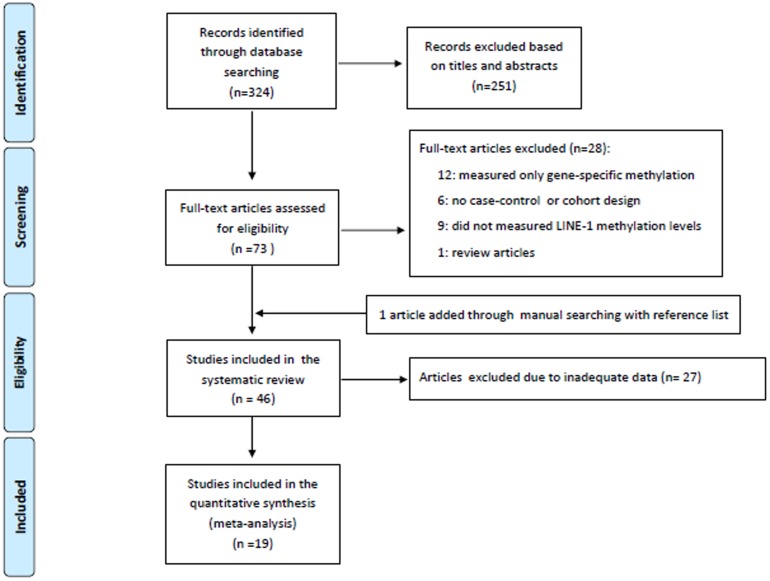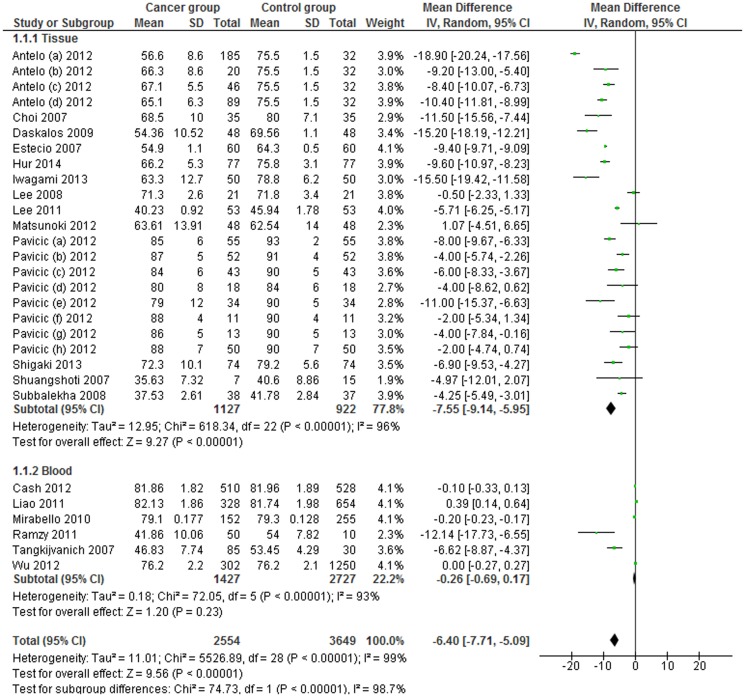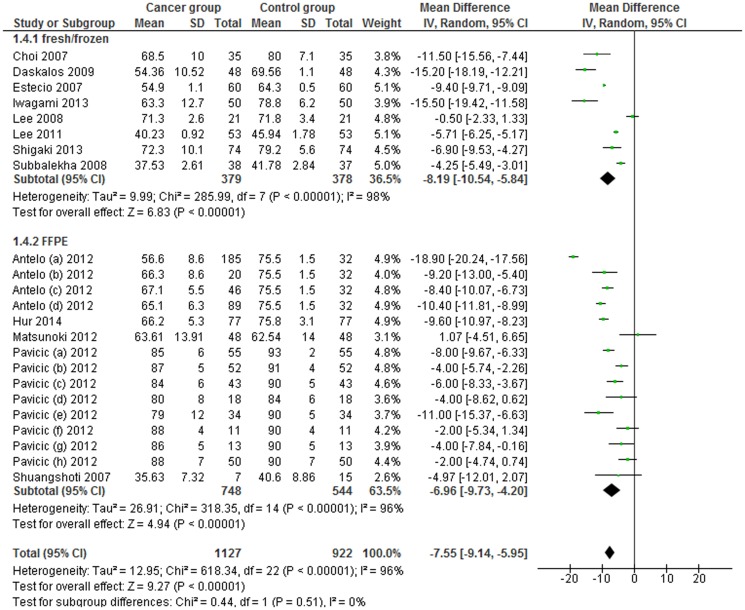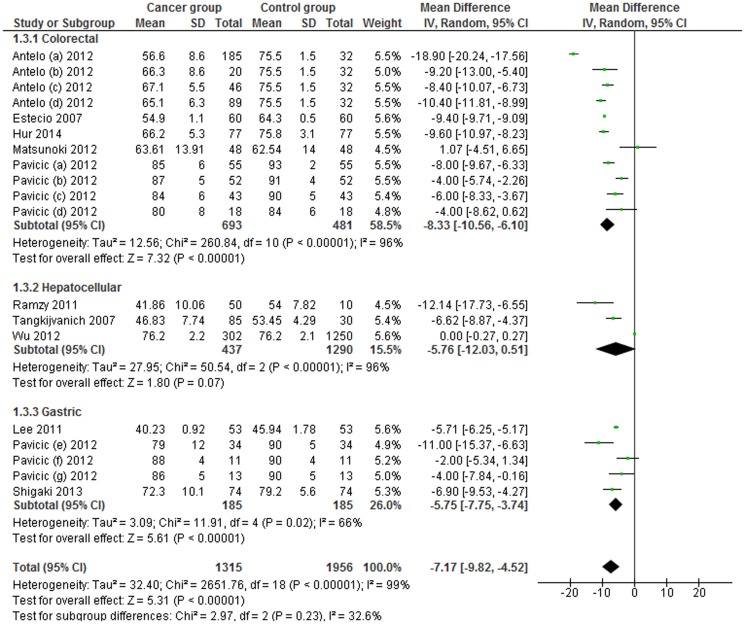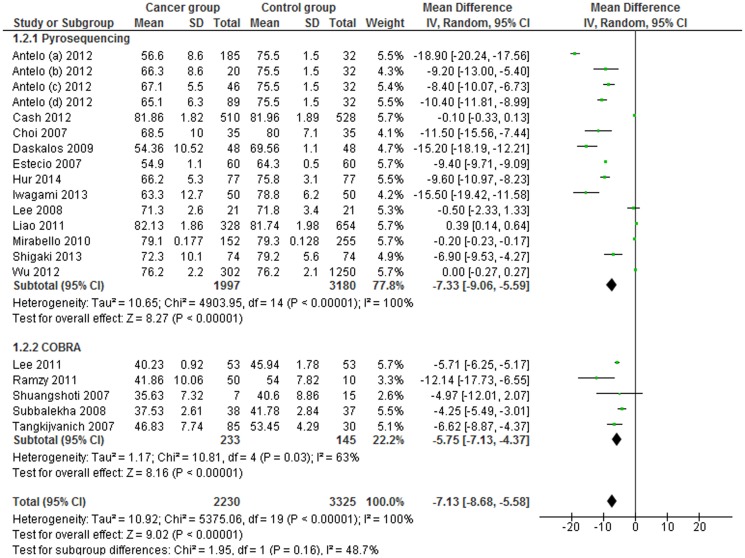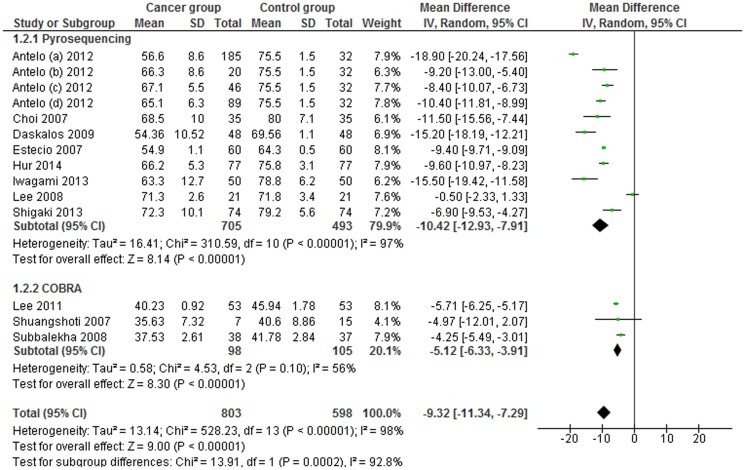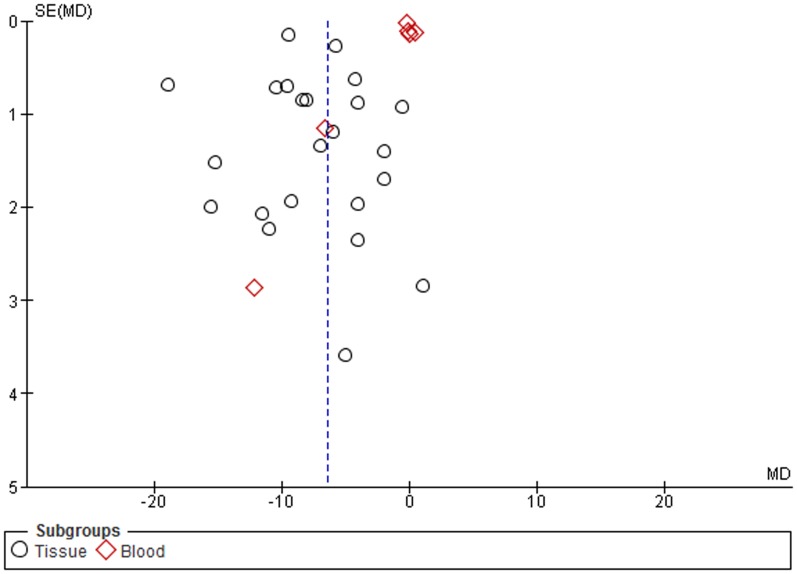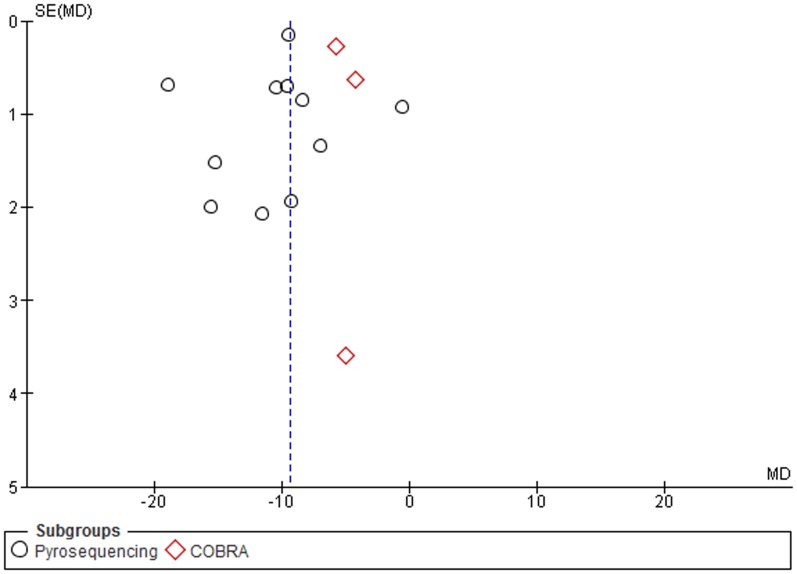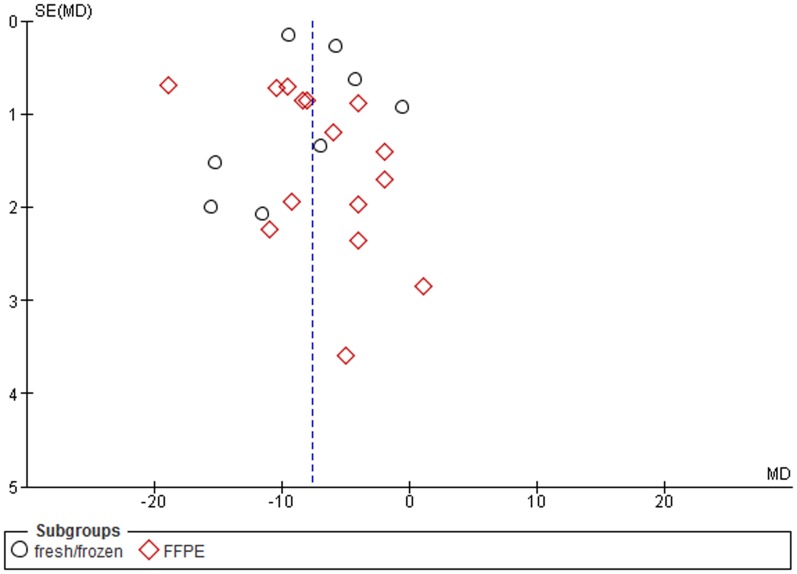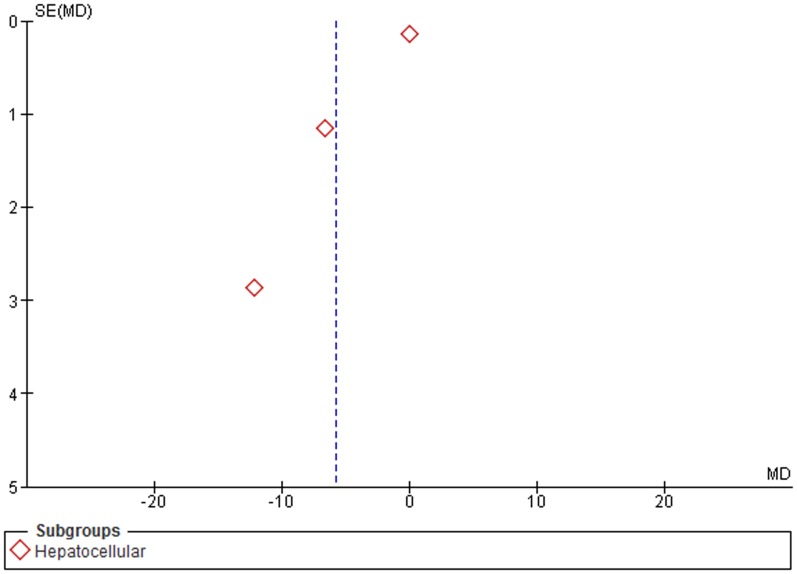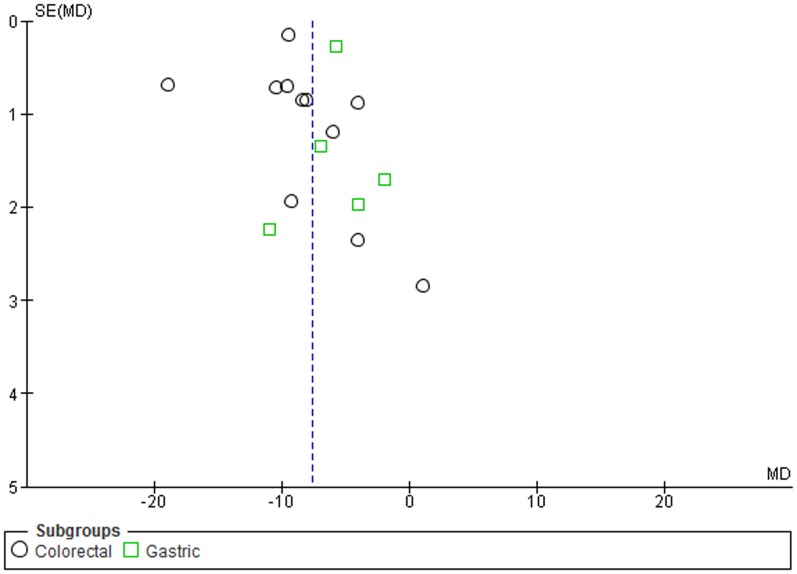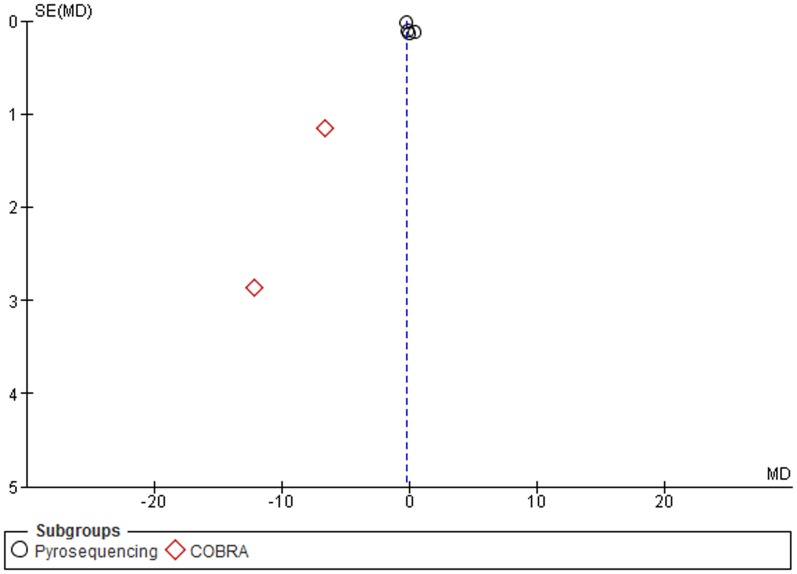Abstract
Objective
A systematic review and a meta-analysis were carried out in order to summarize the current published studies and to evaluate LINE-1 hypomethylation in blood and other tissues as an epigenetic marker for cancer risk.
Methods
A systematic literature search in the Medline database, using PubMed, was conducted for epidemiological studies, published before March 2014. The random-effects model was used to estimate weighted mean differences (MDs) with 95% Confidence Intervals (CIs). Furthermore, subgroup analyses were conducted by sample type (tissue or blood samples), cancer types, and by assays used to measure global DNA methylation levels. The Cochrane software package Review Manager 5.2 was used.
Results
A total of 19 unique articles on 6107 samples (2554 from cancer patients and 3553 control samples) were included in the meta-analysis. LINE-1 methylation levels were significantly lower in cancer patients than in controls (MD: −6.40, 95% CI: −7.71, −5.09; p<0.001). The significant difference in methylation levels was confirmed in tissue samples (MD −7.55; 95% CI: −9.14, −65.95; p<0.001), but not in blood samples (MD: −0.26, 95% CI: −0.69, 0.17; p = 0.23). LINE-1 methylation levels were significantly lower in colorectal and gastric cancer patients than in controls (MD: −8.33; 95% CI: −10.56, −6.10; p<0.001 and MD: −5.75; 95% CI: −7.75, −3.74; p<0.001) whereas, no significant difference was observed for hepatocellular cancer.
Conclusions
The present meta-analysis adds new evidence to the growing literature on the role of LINE-1 hypomethylation in human cancer and demonstrates that LINE-1 methylation levels were significantly lower in cancer patients than in control samples, especially in certain cancer types. This result was confirmed in tissue samples, both fresh/frozen or FFPE specimens, but not in blood. Further studies are needed to better clarify the role of LINE-1 methylation in specific subgroups, considering both cancer and sample type, and the methods of measurement.
Introduction
Epigenetic alterations, heritable DNA modifications that do not involve changes in the DNA sequence, are associated with changes in gene expression and are important in maintaining genomic stability [1]. Among epigenetic mechanisms, DNA methylation is the most commonly studied and involved in various biological processes including cancer [2]–[5]. Global hypomethylation, an overall genome-wide reduction in DNA methylation content, is associated with genomic instability and an increased number of mutational events [6]. Genomic DNA hypomethylation is likely to result from demethylation in repetitive elements, which account for about 55% of the human genome and determine gene regulation and genomic stability [7], [8]. Long Interspersed Nucleotide Element 1 (LINE-1) and Alu repetitive elements are major constituents of interspersed DNA repeats. Due to their high occurrence throughout the genome, methylation in repetitive elements have been shown to correlate with global genomic DNA methylation content and demethylation has been associated with genome instability and chromosomal aberrations. Thus, LINE-1 and Alu have been used as global surrogate markers for estimating the genomic DNA methylation level in cancer tissues [6], [9]–[10] and in peripheral blood leukocytes [11]. LINE-1 hypomethylation was observed in several types of cancer [12]–[14] and was associated with a poor prognosis [15]. In a meta-analysis [11], global DNA hypomethylation in peripheral blood leukocytes was associated with increased cancer risk. Another meta-analysis, investigating genome-wide DNA methylation in peripheral blood DNA and cancer risk, reports a significant inverse association between genomic 5-methylcytosine levels and cancer risk, but no overall risk association using surrogates for genomic methylation, including methylation at the LINE-1 and Alu repetitive elements was found [16]. The aim of the present study was to carry out a more comprehensive systematic review and a meta-analysis in order to summarize the current published studies and to evaluate LINE-1 hypomethylation in blood and other tissues as an epigenetic marker for cancer risk.
Methods
Search strategy and selection criteria
A systematic literature search in the Medline database, using PubMed, was carried out for epidemiological studies, published before March 2014, investigating the association between LINE-1 hypomethylation and cancer risk. The searches were limited to studies written in English; abstracts and unpublished studies were not included. Literature search was conducted independently by two Authors. The following selection criteria were used to search articles and abstracts: (“cancer” or “tumor” or “carcinoma”) AND (“LINE-1” or “Long Interspersed Element-1” or “global”) AND (“hypomethylation” or “methylation”). Moreover, the reference lists from selected articles were checked to search for further relevant studies. No studies were excluded a priori for weakness of design or data quality. Articles were included in the quantitative analysis only if they satisfied the following criteria: (1) case-control or cohort study designs; and (2) studies that reported mean values and standard deviations (SD) of DNA methylation level in cancer patients and in control group. Furthermore exclusion criteria were as follows: (1) the study reporting only results as median of the methylation levels or through graphic display, or 95% confidence intervals (CIs) with adjusted odds ratios (OR) or relative risks for cancer risk in subjects with the lowest level of global DNA methylation (tertile, quartile or decile) compared to group with the highest level, (2) the study reporting only gene-specific DNA methylation analysis, and (3) review articles.
Where there were missing data or additional information were required, study Authors were contacted by email.
The preferred reporting items for systematic reviews and meta-analysis (PRISMA) guidelines for the conduct of meta-analysis were followed [17].
Data collection and extraction
Two of the Authors independently reviewed all the eligible studies and abstracted the following information in a standard format: first Author's last name, year of publication, country where the study was performed, study design, cancer sites and types, sample type, experimental methods to measure global DNA methylation levels, number of cases and controls, mean values and SD of global DNA methylation levels for each group and main results.
Statistical Analysis
All data were analyzed using the REVIEW MANAGER 5.2 software provided by the Cochrane Collaboration (http://ims.cochrane.org/revman).
The random-effects model was used to estimate weighted mean differences (MDs) with 95% CI [18] and thus, no adjustment for environmental effects was taken into account. Furthermore, subgroup analyses were conducted by sample type (tissue or blood samples), by sample source (fresh tissue or formalin-fixed, paraffin-embedded, FFPE tissue), by cancer types (colorectal, stomach, hepatocellular), and by assays used to measure global DNA methylation levels. Forest plots were generated to illustrate the study-specific effect sizes along with a 95% CI. Heterogeneity across studies, was measured using the Q-test based on the χ2 statistic, considering significant statistical heterogeneity as p<0.1. As Cochran's test only indicates the presence of heterogeneity and not its magnitude, we also reported the I2 statistic, which estimates the percentage of outcome variability that can be attributed to heterogeneity across studies. An I2 value of 0% denotes no observed heterogeneity, whereas, 25% is “low”, 50% is “moderate” and 75% is “high” heterogeneity [19]. We also estimated the between-study variance using tau-squared (τ2) statistic [20].
To determine the presence of publication bias, the symmetry of the funnel plots in which mean differences were plotted against their corresponding standard errors were assessed.
Results
Data extraction
The detailed steps of the systematic review and meta-analysis process are given as a PRISMA flow chart in Figure 1. A total of 324 articles were retrieved from the database, one article was added through manual searching with reference list and thus 46 papers, published between 2004 and 2014, were included in the systematic review and summarized in Table 1 by cancer site or type.
Figure 1. Flow diagram of study selection.
Table 1. Studies included in the systematic review and in the meta-analysis.
| Author (Year) | Country | Study design | Cancer type | Sample type | Assay | Number of cases/controls | Mean (SD) Cases | Mean (SD) Controls | Results |
| Antelo (2012)a* | Argentina | Retrospective | Colorectal (Early Onset) | Tissue | Pyrosequencing | 185/32 | 56.6 (8.6) | 75.5 (1.5) | Early-onset CRC had significantly lower LINE-1 methylation levels than any other group |
| Antelo (2012)b* | Argentina | Retrospective | Colorectal (Lynch Syndrome) | Tissue | Pyrosequencing | 20/32 | 66.3 (4.5) | 75.5 (1.5) | |
| Antelo (2012)c* | Argentina | Retrospective | Colorectal (Older Onset sporadic MSI-high) | Tissue | Pyrosequencing | 46/32 | 67.1 (5.5) | 75.5 (1.5) | |
| Antelo (2012)d* | Argentina | Retrospective | Colorectal (Older Onset sporadic MSS/MSI-low) | Tissue | Pyrosequencing | 89/32 | 65.1 (6.3) | 75.5 (1.5) | |
| Choi (2007)* | USA | Retrospective | Neuroendocrine | Tissue | Pyrosequencing | 35/35 | 68.5 (10.0) | 80.0 (7.1) | LINE-1 methylation levels were significantly lower in cancer tissues than in normal adjacent tissues |
| Daskalos (2009)* | UK | Retrospective | Lung | Tissue | Pyrosequencing | 48/48 | 54.36 (10.52) | 69.56 (1.1) | LINE-1 methylation levels were significantly lower in cancer tissues than in normal adjacent tissues |
| Estecio (2007)* | USA | Retrospective | Colorectal and various cancer cell lines | Tissue | Pyrosequencing | 60/60 | 54.9 (1.1) | 64.3 (0.5) | LINE-1 methylation levels were significantly lower in cancer tissues than in normal adjacent tissues |
| Hur (2014)* | Spain | Retrospective | Colorectal | Tissue | Pyrosequencing | 77/77 | 66.2 (5.3) | 75.8 (3.10) | Compared with normal adjacent mucosa, both primary cancer and metastasis tissue were significantly hypomethylated at LINE-1 elements |
| Iwagami (2013)* | Japan | Prospective | Esophageal | Tissue | Pyrosequencing | 50/50 | 63.3 (12.7) | 78.8 (6.2) | LINE-1 methylation levels were significantly lower in cancer tissues than in normal adjacent tissues |
| Lee (2008)* | Sweden | Retrospective | Thyroid | Tissue | Pyrosequencing | 21/21 | 71.3 (2.6) | 71.8 (3.4) | LINE-1 methylation changes are not observed between cancer and normal tissues |
| Lee (2011)* | South Korea | Retrospective | Gastric | Tissue | COBRA LINE-1 | 53/53 | 40.23 (0.92) | 45.94 (1.78) | LINE-1 methylation levels were significantly lower in cancer tissues than in normal adjacent tissues |
| Matsunoki (2012)* | Japan | Retrospective | Colorectal | Tissue | MulticolorMethyLight Assay | 48/48 | 63.61 (13.91) | 62.54 (14) | LINE-1 methylation levels were significantly lower in cancer tissues than in normal adjacent tissues |
| Pavicic (2012)a* | Finland | Retrospective | Colorectal (Sporadic MSS) | Tissue | MS-MLPA | 55/55 | 85 (6) | 93 (2) | LINE-1 methylation levels were significantly lower in cancer tissues than in normal adjacent tissues |
| Pavicic (2012)b* | Finland | Retrospective | Colorectal (Sporadic MSI) | Tissue | MS-MLPA | 52/52 | 87 (5) | 91 (4) | LINE-1 methylation levels were significantly lower in cancer tissues than in normal adjacent tissues |
| Pavicic (2012)c* | Finland | Retrospective | Colorectal (Lynch Syndrome) | Tissue | MS-MLPA | 43/43 | 84 (6) | 90 (5) | LINE-1 methylation levels were significantly lower in cancer tissues than in normal adjacent tissues |
| Pavicic (2012)d* | Finland | Retrospective | Colorectal (FCCX) | Tissue | MS-MLPA | 18/18 | 80 (8) | 84 (6) | LINE-1 methylation levels were significantly lower in cancer tissues than in normal adjacent tissues |
| Pavicic (2012)e* | Finland | Retrospective | Gastric (Sporadic MSS) | Tissue | MS-MLPA | 34/34 | 79 (12) | 90 (5) | LINE-1 methylation levels were significantly lower in cancer tissues than in normal adjacent tissues |
| Pavicic (2012)f* | Finland | Retrospective | Gastric (Sporadic MSI) | Tissue | MS-MLPA | 11/11 | 88 (4) | 90 (4) | LINE-1 methylation levels were significantly lower in cancer tissues than in normal adjacent tissues |
| Pavicic (2012)g* | Finland | Retrospective | Gastric (Lynch Syndrome) | Tissue | MS-MLPA | 13/13 | 86 (5) | 90 (5) | LINE-1 methylation levels were significantly lower in cancer tissues than in normal adjacent tissues |
| Pavicic (2012)h* | Finland | Retrospective | Endometrial (Lynch Syndrome) | Tissue | MS-MLPA | 50/50 | 88 (7) | 90 (7) | LINE-1 methylation levels were significantly lower in cancer tissues than in normal adjacent tissues |
| Shigaki (2013)* | Japan | Prospective | Gastric | Tissue | Pyrosequencing | 74/74 | 72.3 (10.1) | 79.2 (5.6) | LINE-1 methylation levels were significantly lower in cancer tissues than in normal adjacent tissues |
| Shuangshoti (2007)* | Thailand | Retrospective | Cervix uterine | Tissue | COBRA LINE-1 | 7/15 | 35.63 (7.32) | 40.6 (8.86) | LINE-1 methylation levels were significantly lower in cancer patients than in healthy subjects |
| Subbalekha (2008)* | Thailand | Retrospective | Head and Neck | Oral rinses | COBRA LINE-1 | 38/37 | 37.53 (2.61) | 41.78 (2.84) | LINE-1 methylation levels were significantly lower in cancer patients than in healthy subjects |
| Cash (2012)* | China | Retrospective | Bladder | Blood | Pyrosequencing | 510/528 | 81.86 (1.82) | 81.96 (1.89) | LINE-1 methylation were comparable in cases and controls |
| Liao (2011)* | Central and eastern Europe | Retrospective | Renal cell | Blood | Pyrosequencing | 328/654 | 82.13 (1.86) | 81.74 (1.98) | LINE-1 methylation levels were significantly higher in cancer patients than in healthy subjects |
| Mirabello (2010)* | USA | Retrospective | Testicular | Blood | Pyrosequencing | 152/255 | 79.1 (0.177) | 79.3 (0.128) | There was no significant difference between LINE-1 methylation levels in cases and controls |
| Ramzy (2011)* | Egypt | Retrospective | Hepatocellular | Blood | COBRA LINE-1 | 50/10 | 41.86 (10.06) | 54.00 (7.82) | LINE-1 methylation levels were significantly lower in cancer patients than in healthy subjects |
| Tangkijvanich (2007)* | Thailand | Retrospective | Hepatocellular | Blood | COBRA LINE-1 | 85/30 | 46.83 (7.74) | 53.45 (4.29) | LINE-1 methylation levels were significantly lower in cancer patients than in healthy subjects |
| Wu (2012)* | Taiwan | Retrospective | Hepatocellular | Blood | Pyrosequencing | 302/1250 | 76.2 (2.2) | 76.2 (2.1) | There was no significant difference between LINE-1 methylation levels in cases and controls |
| Baba (2010) | USA | Prospective | Colorectal | Tissue | Pyrosequencing | 869/NA | Tumor LINE-1 methylation data indicate enormous epigenomic diversity of individual colorectal cancers | ||
| Bae (2012) | South Korea | Prospective | Gastric | Tissue | Pyrosequencing | 447(two sets of 249 and 198)/NA | LINE-1 hypomethylation is an early event in carcinogenesis and it may be a prognostic indicator independent of cancer stage | ||
| Bollati (2009) | Italy | Retrospective | Multiple Myeloma | Bone marrow aspirates | Pyrosequencing | 76/11 | Cases showed a decrease of LINE-1 methylation levels compared to controls | ||
| Chalitchagorn (2004) | Thailand | Retrospective | Gastric | Blood | COBRA LINE-1 | 17/17 | Cases showed a decrease of LINE-1 methylation levels compared to controls | ||
| Choi (2009) | USA | Retrospective | Breast | Blood | Pyrosequencing | 19/18 | There was no significant difference between LINE-1 methylation levels in cases and controls | ||
| Dammann (2010) | Germany | Retrospective | Ovarian | Tissue | QUBRA | 22/NA | High prevalence of LINE1 hypomethylation throughout all tumor stages | ||
| Di (2011) | China | Retrospective | Hepatocellular | Blood | Pyrosequencing | 315/356 | Hypomethylation lead to a significant 2.6-fold increased risk for HCC | ||
| Fabris (2011) | Italy | Retrospective | Chronic lymphocytic leukemia | Blood | Pyrosequencing | 77/7 | LINE-1 methylation levels were significantly lower in cancer patients than in healthy subjects | ||
| Gao (2012) | China | Retrospective | Gastric | Blood | Pyrosequencing | 192/384 | There was no significant difference between LINE-1 methylation levels in cases and controls | ||
| Gao (2013) | China | Prospective | Hepatocellular | Tissue | Sequencing and Real-time qPCR | 243/48 | Hypomethylation of LINE-1 was associated with tumour progression, larger tumour size, higher recurrence rates, worse tumour stage and poor tumour differentiation | ||
| Geli (2008) | Sweden | Retrospective | Pheochromocytoma and Paraganglioma | Tissue | Pyrosequencing | 55/NA | Cases showed a decrease LINE-1 methylation levels compared with controls | ||
| Hsiung (2007) | USA | Retrospective | Head and Neck | Blood | COBRA LINE-1 | 278/526 | The median methylation level in controls was slightly but significantly higher than the median level in cases. Hypomethylation lead to a significant 1.6-fold increased risk for disease | ||
| Hou (2010) | Poland | Retrospective | Gastric | Blood | Pyrosequencing | 302/421 | Cancer risk was highest among those with lowest level of methylation in LINE-1 relative to those with the highest levels, although the trends were not statistically significant | ||
| Igarashi (2010) | Japan | Retrospective | GIST | Tissue | Pyrosequencing | 106/NA | LINE-1 hypomethylation correlates significantly with the aggressiveness of tumors and it could be a useful marker for risk assessment | ||
| Kreimer (2013) | Germany | Retrospective | Bladder | Tissue | Pyrosequencing | 23/12 | LINE-1 methylation was significantly decreased in cancers compared to normal tissues with striking differences in their percent median values | ||
| Ogino (2008) | USA | Prospective | Colorectal | Tissue | Pyrosequencing | 643/NA | LINE-1 hypomethylation was linearly associated with a statistically significant increase in cancer – specific mortality | ||
| Phokaew (2008) | Thailand | Retrospective | Head and Neck | Tissue | COBRA LINE-1 | 11/12 | LINE-1 methylation level at each locus is different, it can be influenced differentially depending on where the particular sequences are located in the genome | ||
| Pobsook (2011) | Thailand | Retrospective | Head and Neck | Various | COBRA LINE-1 | 90/114 | LINE-1 partial methylation represents hypomethylation in normal cells but hypermethylation in cancer cells | ||
| Saito (2010) | Japan | Retrospective | Lung | Tissue | Real-time PCR | 379/333 | LINE-1 methylation levels were significantly lower in cancer patients than in healthy subjects | ||
| Sigalotti (2011) | Italy | Retrospective | Melanoma | Tissue | Pyrosequencing | 42/4 | LINE-1 methylation is identified as a molecular marker of prognosis | ||
| Sunami (2011) | USA | Retrospective | Colorectal | Tissue | AQAMA-PCR | 117/117 | LINE-1 hypomethylation was significantly greater in adenoma tissue compared to its contiguous normal epithelium and cancer mesenchymal tissue | ||
| Trankenschuh (2010) | Germany | Retrospective | FLC | Tissue | Pyrosequencing | 25/15 | No evidence of global hypomethylation was found | ||
| Van Hoesel (2012) | USA | Prospective | Breast | Tissue | AQAMA-PCR | 129/109 | LINE-1 hypomethylation is a prognostic biomarker of poor outcome | ||
| Wilhelm 2010 | USA | Retrospective | Bladder | Blood | Pyrosequencing | 285/465 | Being in the lowest LINE1 methylation decile was associated with a significant 1.8-fold increased risk of cancer | ||
| Wolff (2010) | USA | Retrospective | Bladder | Tissue | Pyrosequencing | 113/63 | Cases showed a decrease LINE-1 methylation levels compared with controls | ||
| Yegnasubramanian (2008) | USA | Retrospective | Prostate | Tissue | COMPARE | 76/24 | Cases showed a decrease LINE-1 methylation levels compared with controls | ||
| Zhu (2011) | USA | Retrospective | Various | Blood | Pyrosequencing | 205/487 | Individuals with lowest LINE-1 methylation levels had a significant 4.4-fold increased incidence of lung cancer. No significant associations were observed for other tumors |
(*) Studies included in the meta-analysis (N = 19).
AQAMA-PCR: Absolute Quantitative Assessment Of Methylated Alleles PCR, COBRA LINE-1: Combined Bisulfite Restriction Analysis LINE-1, COMPARE: Combination Of Methylated DNA Precipitation And Restriction Enzyme digestion, CRC: Colorectal Cancer, FCCX: Familial Colorectal Cancer type X, FLC: Fibrolamellar Carcinoma, GIST: Gastrointestinal Stromal Tumors, LINE-1: Long Interspersed Nucleotide Element 1, MSI: MicroSatellite Instable, MS-MLPA: Methylation-Specific Multiplex Ligation-dependent Probe Amplification, MSS: MicroSatellite Stable, QUBRA: Quantitative Bisulfite Restriction Analysis.
Data characteristics and quality assessment
A total of 18 studies were from Asian countries (40%), 13 from European countries (28%), 13 from USA (28%) and 1 from Argentina and from Egypt (2%, each).
Thirty-eight retrospective longitudinal studies compared LINE-1 methylation levels between cancer patients and healthy subjects or normal adjacent tissues in cancer patients. Eight prospective longitudinal studies analysed LINE-1 methylation levels in cohorts of cancer patients, in relation to the life expectancy, the outcome of the disease or the malignancy of the tumor, identifying the role of LINE-1 hypomethylation as a biomarker of poor prognosis in cancer patients [15], [21]–[27].
In 41 studies LINE-1 methylation levels were evaluated both in tumor and in healthy controls tissues, and in the remaining 5 studies only in cancer patients.
Overall, the studies detected LINE-1 methylation levels in 15332 samples: 8103 from cancer patients (4679 tissue samples, 3276 blood samples ,72 oral rinses and 76 bone marrow plasma cells) and 7136 control samples (6277 from healthy subjects and 859 from normal adjacent tissues in cancer patients).
Regarding the experimental methods to measure LINE-1 methylation levels, the “gold standard” method, used in 63% of studies, was the pyrosequencing of bisulphite converted DNA. Furthermore, 9 studies used combined bisulphite restriction analysis of LINE-1 (COBRA LINE-1) and 8 studies used other methods, i.e. sequencing, real-time PCR, AQAMA PCR, COMPARE methylation assay, MulticolorMethyLight Assay and MS-MLPA.
The most frequent tumor type in study was colorectal cancer analyzed in eight studies [15], [21], [28]–[33], followed by seven studies that evaluated methylation level in gastric cancer [23], [27], [32], [34]–[37], five in hepatocellular carcinoma [25], [38]–[41], four in bladder cancer [1], [14], [42], [43] and head and neck carcinoma [10], [44]–[46], two in lung cancer [47], [48] and breast cancer [24], [49], and single studies assessed methylation levels in renal cell cancer [50], prostate cancer [51], neuroendocrine tumor [52], ovarian cancer [53], thyroid cancer [54], esophageal cancer [26], cervix cancer [55], endometrial cancer [32], skin melanoma [22], testicular cancer [56], leukemia [57], multiple myeloma [58], paraganglioma [59], fibrolamellar carcinoma [60] and gastrointestinal [61]. Four studies evaluated methylation level in several cancer sites [13], [28], [29], [32]. With regard to the assay method, pyrosequencing was used in 29 studies, followed by COBRA in 9 studies, Real-Time PCR and AQAMA-PCR in 2 studies. MulticolorMethyLight Assay, MS-MLP, COMPARE and QUBRA were adopted in single study each.
Meta-analysis
Of the 46 selected papers, 14 reported means and SD of DNA methylation levels. In addition, means and SDs were independently calculated using data from 2 articles and, among Authors contacted for missing data, 3 responded to the email requests and data were added in the analysis [30], [50], [56]. Thus, 19 unique articles were included in the quantitative analysis. Furthermore, two papers by Antelo et al. [28] and by Pavicic et al. [32], reported data from different cancer types and thus, they were separated in 4 and 8 sub-studies, respectively (Table 1).
A total of 6107 samples were included in the analysis: 2554 from cancer patients (1127 tissue samples and 1427 blood samples) and 3553 control samples (2811 from healthy subjects and 742 from normal adjacent tissues in cancer patients).
LINE-1 methylation levels were significantly lower in cancer patients than in control samples (MD: −6.40, 95% CI: −7.71, −5.09; p<0.001). However, heterogeneity between studies was significantly high (I2 = 99%) ( Figure 2 ), thus, subgroup analysis based on sample type (tissue or blood samples) was performed. The significant difference in methylation levels was confirmed in tissue samples (MD −7.55; 95% CI: −9.14, −65.95; p<0.001), but not in blood samples (MD: −0.26, 95% CI: −0.69, 0.17; p = 0.23).
Figure 2. Forest plot of the mean difference of LINE-1 methylation levels between cancer and control groups in tissue and blood samples.
Subgroup analysis based on sample type.
A subgroup analysis by sample source was conducted. LINE-1 methylation levels were significantly lower in cancer patients than in control samples in fresh and/or frozen tissue (MD −8.19; 95% CI: −10.54, −5.84; p<0.001) and in FFPE tissue (MD: −6.96; 95% CI: −9.73, −4.20; p<0.001). Heterogeneity between studies, in the two subgroups was significantly high (I2 = 98% and 96% respectively) ( Figure 3 ).
Figure 3. Forest plot of the mean difference of LINE-1 methylation levels between cancer and control groups in tissue samples.
Subgroups analysis based on sample source.
Furthermore, a subgroup analysis by specific cancer types, for colorectal, hepatocellular and gastric cancer, was conducted. LINE-1 methylation levels were significantly lower in colorectal and gastric cancer patients than in control samples (MD: −8.33; 95% CI: −10.56, −6.10; p<0.001 and MD: −5.75; 95% CI: −7.75, −3.74; p<0.001). No difference of LINE-1 methylation levels in blood leukocytes was observed for hepatocellular cancer (MD: −5.76; 95% CI: −12.03, +0.51; p = 0.23). Heterogeneity between studies, in colorectal and hepatocellular subgroups was significantly high (I2 = 96%), and moderately high in the gastric subgroups (I2 = 66%) ( Figure 4 ).
Figure 4. Forest plot of the mean difference of LINE-1 methylation levels between cancer and control groups.
Subgroups analysis based on cancer type.
A subgroup analysis by assays used to measure the methylation levels, and particularly, between the two commonly used techniques, pyrosequencing and COBRA LINE-1, was performed. The MDs for pyrosequencing and COBRA LINE-1 subgroups were -7.33 (95% CI: −9.06, −5.59; p<0.001) and −5.75 (95% CI: −7.13, −4.37; p = 0.03), respectively. Heterogeneity between studies and in the pyrosequencing subgroup was significantly high (I2 = 100%), and moderately high in the COBRA subgroup (I2 = 63%) ( Figure 5 ).
Figure 5. Forest plot of the mean difference of LINE-1 methylation levels between cancer and control groups.
Subgroups analysis based on method.
A subgroup analysis by sample type, particularly tissue samples, and assay method was conducted. The MDs in the subgroups of studies which detected LINE-1 methylation levels in tissue samples through pyrosequencing and COBRA LINE-1, were −10.42 (95% CI: −12.93, −7.91; p<0.001) and −5.12 (95% CI: −6.33, −3.91; p = 0.10), respectively. Heterogeneity between studies and in the pyrosequencing subgroup was significantly high (I2 = 97%), moderately high in COBRA LINE-1 subgroup (I2 = 56%) ( Figure 6 ). Stratification among studies which detected LINE-1 methylation in blood samples was not performed due to the paucity of studies.
Figure 6. Forest plot of the mean difference of LINE-1 methylation levels between cancer and control groups in tissue samples.
Subgroups analysis based on method.
The funnel plots indicate small to moderate asymmetry, suggesting that publication bias cannot be completely excluded as a factor of influence on the present meta-analysis ( Figures 7 – 12 ).
Figure 7. Funnel plot.
Subgroup analysis based on sample type.
Figure 12. Funnel plot.
Subgroup analysis based on detection method in tissue samples.
Figure 8. Funnel plot.
Subgroup analysis based on tissue specimen types. SE, standard error, MD, mean difference.
Figure 9. Funnel plot.
Subgroup analysis based on cancer type in blood samples.
Figure 10. Funnel plot.
Subgroup analysis based on cancer type in tissue samples.
Figure 11. Funnel plot.
Subgroup analysis based on detection method in blood samples.
Discussion
The low level of DNA methylation in tumors compared with DNA methylation level in their normal-tissue counterparts was one of the first epigenetic alterations to be found in human cancer [62]. The loss of methylation is mainly due to hypomethylation of repetitive DNA sequences and LINE-1 elements are typically heavily methylated in normal tissues, while LINE-1 hypomethylation has been reported in cancer tissues. Furthermore, Liao et al. [50] reported that LINE-1 methylation levels, measured in leukocyte DNA, were significantly higher in renal cancer patients than in healthy subjects.
Two recent meta-analyses were conducted in order to estimate overall cancer risk according to global DNA hypomethylation in blood leukocytes. The meta-analysis by Woo and Kim [11] reports that global DNA hypomethylation of blood leukocytes was associated with increased cancer risk, although the association varied by the experimental methods used (% 5- methylcytosine method, LINE-1 with pyrosequencing and methyl acceptance assay), the region of DNA targeted and the cancer type. An updated meta-analysis performed by Brennan and Flanagan [16] indicates a significant inverse association between genomic 5-methylcytosine levels and cancer risk (OR = 3.65; 1.20–6.09), but no overall risk association for studies using surrogates for genomic methylation, including methylation at the LINE-1 repetitive element (OR = 1.24; 0.76–1.72). Notably, the previous two meta-analyses included studies reporting association analysis between blood methylation levels and cancer risk but did not evaluate studies reporting differences in mean methylation levels in blood and in other tissues. The present meta-analysis of recent reports was conducted including studies reporting methylation levels in blood and in other tissues. This meta-analysis concerned 19 unique articles, but since two articles comprised more than one study conducted on different patient populations, altogether there were 29 non-unique studies included. On a total of 2554 samples from cancer patients and 3553 control samples, this meta-analysis reports that mean methylation levels in cancer patients were significantly 6.4% lower than in control samples.
The association between cancer risk and global DNA methylation has been mostly investigated in blood samples, because harvesting tumor tissue is invasive and cannot be routinely performed. However, several studies have reported that methylation of repetitive elements is tissue specific, most variable in tumor tissue, and is not correlated between tumor and blood [63]–[65]. Consistently, evidence reveals that genomic hypomethylation in tumor and normal adjacent tissue of bladder and colon cancer was not detectable in blood [43], [66], suggesting that hypomethylation is restricted to the disease affected tissue. Interestingly, in the present meta-analysis the significant difference in mean methylation levels was confirmed only in tissue samples, both fresh/frozen or FFPE specimens, but not in blood samples. Furthermore, the meta-analysis provided sufficient evidence that LINE-1 hypomethylation, significantly increases in colorectal and gastric cancer. On the contrary, no overall association was found for hepatocellular carcinoma. Notably, all studies focusing on colorectal and gastric tumors evaluated LINE-1 methylation in tissue samples, while all the included studies on hepatocellular carcinoma investigated the association only in blood leukocyte samples. Global DNA methylation can be measured by direct and indirect quantification assays. Although the measurement of percentages of 5- methylcytosine to estimate global DNA methylation contents are highly quantitative and reproducible, they require high amount of DNA and are not suitable for large epidemiological studies. Pyrosequencing with bisulfite-treated DNA, the "gold standard" for DNA methylation analysis [67], [68], is a high-throughput and accurate method currently available to measure LINE-1 methylation as surrogate marker for global DNA hypomethylation. However, LINE-1 methylation levels can vary depending on the target CpG sequence detected [69], representing an important factor in the association study with cancer risk. In the present meta-analysis, considering the two most frequently used detection methods (pyrosequencing and COBRA LINE-1) both subgroups report significantly lower LINE-1 methylation levels in cancer patients than in control samples, although heterogeneity between studies was significantly high in the pyrosequencing subgroup and moderately high in the COBRA subgroup.
The main limitations of this meta-analysis are the small number of studies included (n = 19) and the high heterogeneity across studies. Although a random effects model was performed, in order to take into account the high heterogeneity, the pooled estimates should be interpreted with caution. To overcome this issue, pooled estimates were calculated in more homogeneous subsets of studies (subgroups analysis). In addition, the possible existence of a publication bias was considered. Examination of funnel plots showed small to moderate asymmetry, suggesting that publication bias cannot be completely excluded and may have had at least a moderate impact on the true effect size estimates. In fact, some data, such as conference abstracts, non-English literature, unpublished data and other inconsistent reports according to our selection criteria were excluded. Furthermore, methylation-risk association tend only to be reported if it reveals statistically significant results, and if the authors deem analysis appropriate [16].
Moreover, since most studies (83%) had a case-control design large cohort studies are needed in order to clarify if global hypomethylation is an early cancer-causing aberration or an effect of carcinogenesis [11].
In conclusion, the present meta-analysis adds new evidence to the growing literature on the role of LINE-1 hypomethylation in human cancer and shows that LINE-1 methylation levels were significantly lower in cancer patients than in controls, especially for certain cancer types. This result was confirmed in tissue samples but not in blood. Further studies are needed to better clarify the role of LINE-1 methylation in specific subgroups, considering both the cancer and sample type, and the methods of measurement.
Supporting Information
PRISMA Checklist.
(DOC)
Meta-analysis on Genetic Association Studies Checklist.
(DOC)
Acknowledgments
The Authors would like to thank the Authors A. Goel and K. Hur and colleagues, L.M. Liao and L. E. Moore and colleagues and M.H. Greene and L. Mirabello and colleagues for supporting more data not reported in their articles.
Data Availability
The authors confirm that all data underlying the findings are fully available without restriction. All relevant data are within the paper and its Supporting Information files.
Funding Statement
The authors have no funding or support to report.
References
- 1. Cash H, Tao L, Yuan JM, Marsit C, Houseman E, et al. (2012) LINE-1 hypomethylation is associated with bladder cancer risk among non-smoking Chinese. Int J Cancer 130: 1151–1159. [DOI] [PMC free article] [PubMed] [Google Scholar]
- 2. Laird PW, Jaenisch R (1994) DNA methylation and cancer. Hum Mol Genet 3: 1487–1496. [DOI] [PubMed] [Google Scholar]
- 3. Jones PA (1996) DNA methylation errors and cancer. Cancer Res 56: 2463–2467. [PubMed] [Google Scholar]
- 4. Liu L, Wylie RC, Andrews LG, Tollefsbol TO (2003) Aging, cancer and nutrition: the DNA methylation connection. Mech Ageing Dev 124: 989–998. [DOI] [PubMed] [Google Scholar]
- 5. Davis CD, Uthus EO (2004) DNA methylation, cancer susceptibility, and nutrient interactions. Exp Biol Med 229: 988–995. [DOI] [PubMed] [Google Scholar]
- 6. Chen RZ, Pettersson U, Beard C, Jackson-Grusby L, Jaenisch R (1998) DNA hypomethylation leads to elevated mutation rates. Nature 395: 89–93. [DOI] [PubMed] [Google Scholar]
- 7. Lander ES, Linton LM, Birren B, Nusbaum C, Zody MC, et al. (2001) Initial sequencing and analysis of the human genome. Nature 409: 860–921. [DOI] [PubMed] [Google Scholar]
- 8. Rodriguez J, Frigola J, Vendrell E, Risques RA, Fraga MF, et al. (2006) Chromosomal instability correlates with genomewide DNA demethylation in human primary colorectal cancers. Cancer Res 66: 8462–9468. [DOI] [PubMed] [Google Scholar]
- 9. Agnelli L, Bicciato S, Mattioli M, Fabris S, Intini D, et al. (2005) Molecular classification of multiple myeloma: a distinct transcriptional profile characterizes patients expressing CCND1 and negative for 14q32 translocations. J Clin Oncol 23: 7296–7306. [DOI] [PubMed] [Google Scholar]
- 10. Fabris S, Ronchetti D, Agnelli L, Baldini L, Morabito F, et al. (2007) Transcriptional features of multiple myeloma patients with chromosome 1q gain. Leukemia 21: 1113–1116. [DOI] [PubMed] [Google Scholar]
- 11. Woo HD, Kim J (2012) Global DNA Hypomethylation in Peripheral Blood Leukocytes as a Biomarker for Cancer Risk: A Meta-Analysis. PLoS ONE 7: e34615. [DOI] [PMC free article] [PubMed] [Google Scholar]
- 12. Hsiung D, Marsit C, Houseman E, Eddy K, Furniss C, et al. (2007) Global DNA Methylation Level in Whole Blood as a Biomarker in Head and Neck Squamous Cell Carcinoma. Cancer Epidemiol Biomarkers Prev 16: 108–114. [DOI] [PubMed] [Google Scholar]
- 13. Zhu ZZ, Sparrow D, Hou L, Tarantini L, Bollati V, et al. (2011) Repetitive element hypomethylation in blood leukocyte DNA and cancer incidence, prevalence and mortality in elderly individuals: the Normative Aging Study. Cancer Causes Control 22: 437–447. [DOI] [PMC free article] [PubMed] [Google Scholar]
- 14. Wilhelm C, Kelsey K, Butler R, Plaza S, Gagne L, et al. (2010) Implications of LINE1 Methylation for Bladder Cancer Risk in Women. Clin Cancer Res 16: 1682–1689. [DOI] [PMC free article] [PubMed] [Google Scholar]
- 15. Baba Y, Huttenhower C, Nosho K, Tanaka N, Shina K, et al. (2010) Epigenomic diversity of colorectal cancer indicated by LINE-1 methylation in a database of 869 tumors. Molecular Cancer 9: 125. [DOI] [PMC free article] [PubMed] [Google Scholar]
- 16. Brennan K, Flanagan JM (2012) Is there a link between genome-wide hypomethylation in blood and cancer risk? Cancer Prev Res (Phila) 5: 1345–1357. [DOI] [PubMed] [Google Scholar]
- 17. Moher D, Liberati A, Tetzlaff J, Altman DG (2010) PRISMA Group (2010) Preferred reporting items for systematic reviews and meta-analyses: the PRISMA statement. Int J Surg 8: 336–341. [DOI] [PubMed] [Google Scholar]
- 18. Higgins J, Thompson SG, Deeks JJ, Altman DG (2003) Measuring inconsistency in meta-analyses. BMJ 327: 557–560. [DOI] [PMC free article] [PubMed] [Google Scholar]
- 19. Higgins JP, Thompson SG (2002) Quantifying heterogeneity in a meta-analysis. Stat Med 21: 1539–1558. [DOI] [PubMed] [Google Scholar]
- 20.Higgins JPT, Green S (2008) Cochrane handbook for systematic reviews of interventions Version 5.0.0 updated February 2008. The Cochrane Collaboration.
- 21. Ogino S, Nosho K, Kirkner GJ, Kawasaki T, Chan AT, et al. (2012) A cohort study of tumoral LINE-1 hypomethylation and prognosis in colon cancer. J Natl Cancer Inst 100: 1734–1738. [DOI] [PMC free article] [PubMed] [Google Scholar]
- 22. Sigalotti L, Fratta E, Bidoli E, Covre A, Parisi G, et al. (2011) Methylation levels of the “long interspersed nucleotide element-1” repetitive sequences predict survival of melanoma patients. J Transl Med 9: 78. [DOI] [PMC free article] [PubMed] [Google Scholar]
- 23. Bae JM, Shin SH, Kwon HJ, Park SY, Kook M, et al. (2012) ALU and LINE-1 hypomethylations in multistep gastric carcinogenesis and their prognostic implications. Int J Cancer 131: 1323–1331. [DOI] [PubMed] [Google Scholar]
- 24. Van Hoesel A, van de Velde C, Kuppen P, Liefers G, Putter H, et al. (2012) Hypomethylation of LINE-1 in primary tumor has poor prognosis in young breast cancer patients: a retrospective cohort study. Breast Cancer Res Treat 134: 1103–1114. [DOI] [PubMed] [Google Scholar]
- 25. Gao XD, Qu JH, Chang XJ, Lu YY, Bai WL, et al. (2013) Hypomethylation of long interspersed nuclear element-1 promoter is associated with poor outcomes for curative resected hepatocellular carcinoma. Liver Int 34: 136–146. [DOI] [PMC free article] [PubMed] [Google Scholar]
- 26. Iwagami S, Baba Y, Watanabe M, Shigaki H, Miyake K, et al. (2013) LINE-1 Hypomethylation Is Associated With a Poor Prognosis Among Patients With Curatively Resected Esophageal Squamous Cell Carcinoma. Ann Surg 257(3): 449–55. [DOI] [PubMed] [Google Scholar]
- 27. Shigaki H, Baba Y, Watanabe M, Murata A, Iwagami S, et al. (2013) LINE-1 hypomethylation in gastric cancer, detected by bisulfite pyrosequencing, is associated with poor prognosis. Gastric Cancer 16: 480–487. [DOI] [PMC free article] [PubMed] [Google Scholar]
- 28. Antelo M, Balaguer F, Shia J, Shen Y, Hur K, et al. (2012) A High Degree of LINE-1 Hypomethylation Is a Unique Feature of Early-Onset Colorectal Cancer. PLoS ONE 7: e45357. [DOI] [PMC free article] [PubMed] [Google Scholar]
- 29. Estecio MRH, Gharibyan V, Shen L, Ibrahim AEK, Doshi K, et al. (2007) LINE-1 Hypomethylation in Cancer Is Highly Variable and Inversely Correlated with Microsatellite Instability. PLoS ONE 2: e399. [DOI] [PMC free article] [PubMed] [Google Scholar]
- 30. Hur K, Cejas P, Feliu J, Moreno-Rubio J, Burgos E, et al. (2014) Hypomethylation of long interspersed nuclear element-1 (LINE-1) leads to activation of protooncogenes in human colorectal cancer metastasis. Gut 63: 635–646. [DOI] [PMC free article] [PubMed] [Google Scholar]
- 31. Matsunoki A, Kawakami K, Kotake M, Kaneko M, Kitamura H, et al. (2012) LINE-1 methylation shows little intra-patient heterogeneity in primary and synchronous metastatic colorectal cancer. BMC Cancer 12: 574. [DOI] [PMC free article] [PubMed] [Google Scholar]
- 32. Pavicic W, Joensuu E, Nieminen T, Peltomäki P (2012) LINE-1 hypomethylation in familial and sporadic cancer. J Mol Med 90: 827–835. [DOI] [PMC free article] [PubMed] [Google Scholar]
- 33. Sunami E, de Maat M, Vu A, Turner RR, Hoon DSB (2011) LINE-1 Hypomethylation During Primary Colon Cancer Progression. PLoS ONE 6(4): e18884. [DOI] [PMC free article] [PubMed] [Google Scholar]
- 34. Chalitchagorn K, Shuangshoti S, Hourpai N, Kongruttanachok N, Tangkijvanich P, et al. (2004) Distinctive pattern of LINE-1 methylation level in normal tissues and the association with carcinogenesis. Oncogene 23: 8841–8846. [DOI] [PubMed] [Google Scholar]
- 35. Hou L, Wang H, Sartori S, Gawron A, Lissowska J, et al. (2010) Blood leukocyte DNA hypomethylation and gastric cancer risk in a high-risk Polish population. Int J Cancer 127: 1866–1874. [DOI] [PMC free article] [PubMed] [Google Scholar]
- 36. Gao Y, Baccarelli A, Shu XO, Ji BT, Yu K, et al. (2012) Blood leukocyte Alu and LINE-1 methylation and gastric cancer risk in the Shanghai Women's Health Study. Br J Cancer 106: 585–391. [DOI] [PMC free article] [PubMed] [Google Scholar]
- 37. Lee JR, Chung WC, Kim JD, Lee KM, Paik CN, et al. (2011) Differential LINE-1 Hypomethylation of Gastric Low-Grade Dysplasia from High Grade Dysplasia and Intramucosal Cancer. Gut Liver 5: 149–153. [DOI] [PMC free article] [PubMed] [Google Scholar]
- 38. Ramzy I, Omran D, Hamad O, Shaker O, Abboud A (2011) Evaluation of serum LINE-1 hypomethylation as a prognostic marker for hepatocellular carcinoma. Arab J Gastroenterol 12: 139–142. [DOI] [PubMed] [Google Scholar]
- 39. Wu HC, Wang Q, Yang HI, Tsai WY, Chen CJ, et al. (2012) Global DNA methylation levels in white blood cells as a biomarker for hepatocellular carcinoma risk: a nested case–control study. Carcinogenesis 33: 1340–1345. [DOI] [PMC free article] [PubMed] [Google Scholar]
- 40. Tangkijvanich P, Hourpai N, Rattanatanyong P, Wisedopas N, Mahachai V, et al. (2007) Serum LINE-1 hypomethylation as a potential prognostic marker for hepatocellular carcinoma. Clin Chim Acta 379: 127–133. [DOI] [PubMed] [Google Scholar]
- 41. Di JZ, Han XD, Gu WY, Wang Y, Zheng Q, et al. (2011) Association of hypomethylation of LINE-1 repetitive element in blood leukocyte DNA with an increased risk of hepatocellular carcinoma. J Zhejiang Univ-Sci B 12: 805–811. [DOI] [PMC free article] [PubMed] [Google Scholar]
- 42. Kreimer U, Schulz WA, Koch A, Niegisch G, Goering W (2013) HERV-K and LINE-1 DNA methylation and reexpression in urothelial carcinoma. Frontiers in Oncology 3: 255. [DOI] [PMC free article] [PubMed] [Google Scholar]
- 43. Wolff EM, Byun HM, Han HF, Sharma S, Nichols PW, et al. (2010) Hypomethylation of a LINE-1 Promoter Activates an Alternate Transcript of the MET Oncogene in Bladders with Cancer. PLoS Genet 6: e1000917. [DOI] [PMC free article] [PubMed] [Google Scholar]
- 44. Subbalekha K, Pimkhaokham A, Pavasant P, Chindavijak S, Phokaew C, et al. (2009) Detection of LINE-1s hypomethylation in oral rinses of oral squamous cell carcinoma patients. Oral Oncol 45: 184–191. [DOI] [PubMed] [Google Scholar]
- 45. Phokaew C, Kowudtitham S, Subbalekha K, Shuangshoti S, Mutirangura A (2008) LINE-1 methylation patterns of different loci in normal and cancerous cells. Nucleic Acids Res 36: 5704–5712. [DOI] [PMC free article] [PubMed] [Google Scholar]
- 46.Pobsook T, Subbalekha K, Sannikorn P, Mutirangura A (2011) Improved measurement of LINE-1 sequence methylation for cancer detection. Clin Chim Acta 412: ; 314–321. [DOI] [PubMed] [Google Scholar]
- 47. Daskalos A, Nikolaidis G, Xinarianos G, Savvari P, Cassidy A, et al. (2009) Hypomethylation of retrotransposable elements correlates with genomic instability in non-small cell lung cancer. Int J Cancer 124: 81–87. [DOI] [PubMed] [Google Scholar]
- 48. Saito K, Kawakami K, Matsumoto I, Oda M, Watanabe G, et al. (2010) Long Interspersed Nuclear Element 1 Hypomethylation Is a Marker of Poor Prognosis in Stage IA Non–Small Cell Lung Cancer. Clin Cancer Res 16: 2418–2426. [DOI] [PubMed] [Google Scholar]
- 49. Choi JY, James S, Link P, McCann S, Hong C, et al. (2009) Association between global DNA hypomethylation in leukocytes and risk of breast Cancer. Carcinogenesis 30: 1889–1897. [DOI] [PMC free article] [PubMed] [Google Scholar]
- 50. Liao LM, Brennan P, van Bemmel DM, Zaridze D, Matveev V, et al. (2011) LINE-1 Methylation Levels in Leukocyte DNA and Risk of Renal Cell Cancer. PLoS ONE 6: e27361. [DOI] [PMC free article] [PubMed] [Google Scholar]
- 51. Yegnasubramanian S, Haffner M, Zhang Y, Gurel B, Cornish TC, et al. (2008) DNA Hypomethylation Arises Later in Prostate Cancer Progression than CpG Island Hypermethylation and Contributes to Metastatic Tumor Heterogeneity. Cancer Res 68: 8954–67. [DOI] [PMC free article] [PubMed] [Google Scholar]
- 52. Choi IS, Estecio M, Nagano Y, Kim DH, White J, et al. (2007) Hypomethylation of LINE-1 and Alu in well-differentiated neuroendocrine tumors (pancreatic endocrine tumors and carcinoid tumors). Modern Pathology 20: 802–810. [DOI] [PubMed] [Google Scholar]
- 53. Dammann RH, Kirsch S, Schagdarsurengin U, Dansranjavin T, Gradhand E, et al. (2010) Frequent aberrant methylation of the imprinted IGF2/H19locus and LINE1 hypomethylation in ovarian carcinoma. Int J Oncol 36: 171–179. [PubMed] [Google Scholar]
- 54. Lee JJ, Geli J, Larsson C, Wallin G, Karimi M, et al. (2008) Gene-specific promoter hypermethylation without global hypomethylation in follicular thyroid cancer. Int J Oncol 33: 861–869. [PubMed] [Google Scholar]
- 55. Shuangshoti S, Hourpai N, Pumsuk U, Mutirangura A (2007) Line-1 Hypomethylation in Multistage Carcinogenesis of the Uterine Cervix. Asian Pac J Cancer Prev 8: 307–309. [PubMed] [Google Scholar]
- 56. Mirabello L, Savage S, Korde L, Gadalla SM, Greene MH (2010) LINE-1 methylation is inherited in familial testicular cancer kindreds. BMC Med Genet 11: 77. [DOI] [PMC free article] [PubMed] [Google Scholar]
- 57. Fabris S, Bollati V, Agnelli L, Morabito F, Motta V, et al. (2011) Biological and clinical relevance of quantitative global methylation of repetitive DNA sequences in chronic lymphocytic leukemia. Epigenetics 6: 188–194. [DOI] [PMC free article] [PubMed] [Google Scholar]
- 58. Bollati V, Fabris S, Pegoraro V, Ronchetti D, Mosca L, et al. (2009) Differential repetitive DNA methylation in multiple myeloma molecular subgroups. Carcinogenesis 30: 1330–1335. [DOI] [PubMed] [Google Scholar]
- 59. Geli J, Kiss N, Karimi M, Lee JJ, Backdahl M, et al. (2008) Global and Regional CpG Methylation in Pheochromocytomas and Abdominal Paragangliomas: Association to Malignant Behavior. Clin Cancer Res 14: 2551–2559. [DOI] [PubMed] [Google Scholar]
- 60. Trankenschuh W, Puls F, Christgen M, Albat C, Heim A, et al. (2010) Frequent and Distinct Aberrations of DNA Methylation Patterns in Fibrolamellar Carcinoma of the Liver. PLoS ONE 5: e13688. [DOI] [PMC free article] [PubMed] [Google Scholar]
- 61. Igarashi S, Suzuki H, Niinuma T, Shimizu H, Nojima M, et al. (2010) Novel Correlation between LINE-1 Hypomethylation and the Malignancy of Gastrointestinal Stromal Tumors. Clin Cancer Res 16: 5114–5123. [DOI] [PubMed] [Google Scholar]
- 62. Feinberg AP, Vogelstein B (1983) Hypomethylation distinguishes genes of some human cancers from their normal counterparts. Nature 301: 89–92. [DOI] [PubMed] [Google Scholar]
- 63. Zhu ZZ, Hou L, Bollati V, Tarantini L, Marinelli B, et al. (2010) Predictors of global methylation levels in blood DNA of healthy subjects: a combined analysis. Int J Epidemiol 41: 126–139. [DOI] [PMC free article] [PubMed] [Google Scholar]
- 64. Piyathilake CJ, Macaluso M, Alvarez RD, Chen M, Badiga S, et al. (2011) A higher degree of LINE-1 methylation in peripheral blood mononuclear cells, a one-carbon nutrient related epigenetic alteration, is associated with a lower risk of developing cervical intraepithelial neoplasia. Nutrition 27: 513–59. [DOI] [PMC free article] [PubMed] [Google Scholar]
- 65. van Bemmel D, Lenz P, Liao LM, Baris D, Sternberg LR, et al. (2012) Correlation of LINE-1 methylation levels in patient matched buffy coat, serum, buccal cell and bladder tumor tissue DNA samples. Cancer Epidemiol Biomarkers Prev 21: 1143–1148. [DOI] [PMC free article] [PubMed] [Google Scholar]
- 66. Suter CM, Martin DI, Ward RL (2004) Hypomethylation of L1 retrotransposons in colorectal cancer and adjacent normal tissue. Int J Colorectal Dis 19: 95–101. [DOI] [PubMed] [Google Scholar]
- 67. Rakyan VK, Down TA, Balding DJ, Beck S (2011) Epigenome-wide association studies for common human diseases. Nat Rev Genet 12: 529–541. [DOI] [PMC free article] [PubMed] [Google Scholar]
- 68. Beck S, Rakyan VK (2008) The methylome: approaches for global DNA methylation profiling. Trends Genet 24: 231–237. [DOI] [PubMed] [Google Scholar]
- 69. Nelson H, Marsit C, Kelsey K (2011) Global Methylation in Exposure Biology and Translational Medical Science. Environ Health Perspect 119: 1528–1533. [DOI] [PMC free article] [PubMed] [Google Scholar]
Associated Data
This section collects any data citations, data availability statements, or supplementary materials included in this article.
Supplementary Materials
PRISMA Checklist.
(DOC)
Meta-analysis on Genetic Association Studies Checklist.
(DOC)
Data Availability Statement
The authors confirm that all data underlying the findings are fully available without restriction. All relevant data are within the paper and its Supporting Information files.



